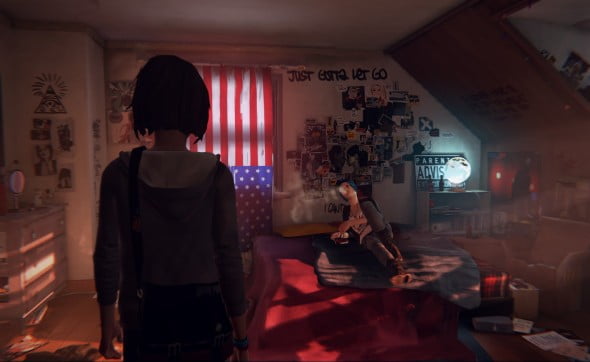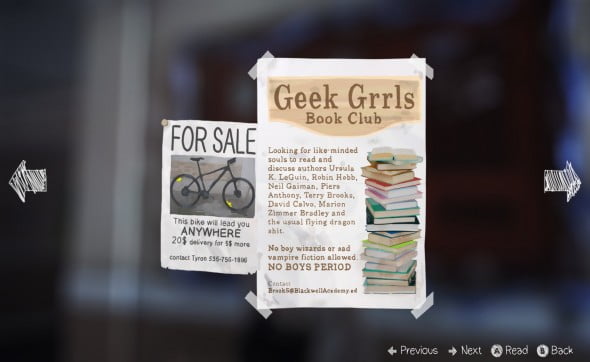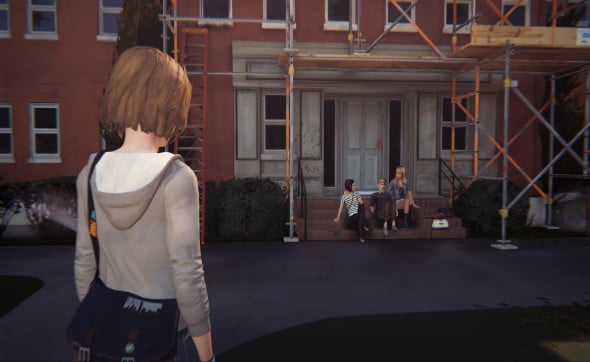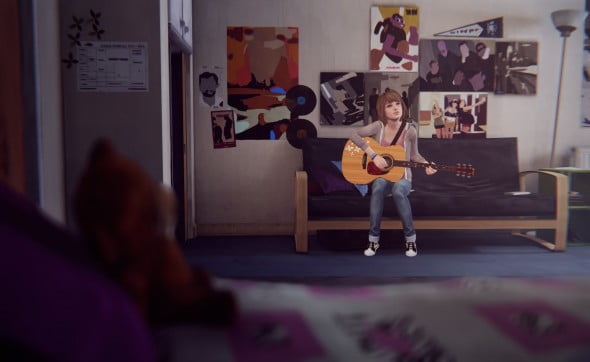Developer: DONTNOD Entertainment
Publisher: Square Enix
Platform: PC (Steam)
Release Date: January 29, 2015
Games criticism is, inherently, a hobbyist medium. It’s all about people who love a thing expressing their love for said thing for all the world to see. Often, a critic can be predisposed towards a game simply by virtue of its themes, mechanics or even art style, and occasionally it can be difficult to get beyond these predispositions when the time comes to flesh out your deeper feelings about an interactive experience. Dontnod’s Life Is Strange is such a game, at least, it is for me.
Set in a contemporary American high school, Life Is Strange is effectively a 3-D exploration-focused, point-and-click adventure with a heavy emphasis on teen drama and supernatural weirdness. Our protagonist, photography student Max Caulfield, discovers that she can rewind time to change events that have already taken place, thus altering the course of the future significantly. At first, she uses this Earth shattering skill to… give her teacher the correct answers in a test, before inevitably using her abilities to more interesting and consequential ends.

As I said before, I’m somewhat predisposed towards Life Is Strange simply because of its style and subject matter. Max is a moody teen who listens to rock music in her headphones (which the player hears, diegetically, I might add) as she wanders the school corridors inwardly passing comment on her classmates, and every line of dialogue is delivered with enough ham and cheese to cater a small wedding reception. This plays as both a strength and weakness for Life Is Strange – at times its cheesy-ness evokes obscure and oddball kid’s TV dramas of the 90s like Animorphs or the lesser known British series Jeopardy, but all too often a line of dialogue or particular narrative turn can render proceedings too cringe-worthy for even my sensibilities. This tendency towards awkward “jokes” and hammy acting is never helped by the game’s near-non-existent lip syncing, which is always on hand (or rather not) to make conversations look like badly dubbed Febreze adverts.
This same level of awkward unpolished-ness extends to the game’s visuals too. Not quite photo-realistic, not quite cell shaded – Life Is Strange looks like a close up view of The Sims 2. Hand drawn photographs, posters and notices are a really nice touch, but the game’s aesthetic quality varies wildly. At times, environments are gorgeously lit and popping with colour. At others, they simply look washed-out and unfinished, as though a forgotten texture is just waiting to pop-in.

With all this in mind, however, the game’s awkward ticks regress further and further into the background as its intriguing mystery unfolds. Since we’re still on Episode One here, not an awful lot is revealed about Life Is Strange‘s plot, but the game expertly drip feeds information without clumsy exposition dumps, and everything unfolds organically and at a remarkably understated pace. Taking more than a few pages out of Gone Home‘s book, Life Is Strange doles out most of its narrative progression through item examination, albeit with the added benefit of The Walking Dead-style conversations.
In many ways, it feels as though more effort has been put into crafting an interesting and believable world than into writing high quality dialogue. When admiring dorms and hallways, it’s thoroughly engaging to be enveloped by Life Is Strange’s quirky polaroid view of small town America – sly nods to punk culture and cult films regularly kept me smiling, as did finding out interesting information about characters by reading laptops or notices. We know that a girl is missing from Blackwell Academy, because her missing posters litter the school halls, and we’re aware that the school’s head of security might not be what he seems. The only problem is, these same wholesome nuggets of storytelling feel a tad forced when they come up in conversation. For example: at one instance, Max needs to retrieve her friend Warren’s flash drive from her dorm room. She’d borrowed it in order to indulge in his collection of cult cinema, which came across as a charming and believable way to drip-feed more information about these characters. Unfortunately, when we meet Warren, the two begin what feels like an awfully clumsy and flat footed conversation wherein Dontnod’s designers have attempted to shoehorn in as many “I’ve seen that!” cult film references as they possibly can. (As an aside, there’s also a Final Fantasy reference – “The Spirits Within is the best sci-fi movie ever!” – which comes off as the worst level of pandering, given that Life Is Strange was published by Square Enix).

Some of these character beats come across as genuine, and they evoke the same novel, nostalgic feelings that Gone Home‘s Riot Grrll soundtrack and Street Fighter command lists did. But when they don’t work, these moment come off as awfully cloying, as do many of the characters tendencies to spout “youth culture” phrases like “selfie”, “chillax” and “kidz” (yes that’s a “z”). This is rather unfortunate, because Max and her colleagues are actually finely crafted characters enveloped by an interesting story, so it’s a shame to see them speak like a parent’s approximation of what “cool kidz” talk like.
Eventually though, Life Is Strange ramps up to a rather impressive climax, none of which would be possible without the game’s genuinely novel Time Rewind mechanic. As with The Walking Dead Game, Max makes choices both large and small. These can range from allowing the nerdy art student to draw your portrait, to reporting an armed student to the principal. Thanks to Max’s new-found powers, though, if you’re unsatisfied with the immediate consequences a choice brings, you can change it for an allegedly better one. Of course, you can’t rewind further back than a few major incidents, so actions still come with an all important sense of permanence and narrative weight. I really dug this system, mostly because it adds a whole new dynamic to conversations. Not satisfied with the answer you just gave a character? Why not rewind and change it so that they like you more? It doesn’t always provide ground breaking narrative changes, but it always changes the dynamic of the game’s story in a thoroughly fascinating way.

It’s also satisfying to see these choices affect characters within the game’s first episode, rather than simply as a set up for promised consequences further down the line. I let the art student draw me, and later I found his drawing on Max’s social network feed in her dorm room, and characters brought up the drawing in conversation. To see such minor choices be given a sense of dramatic weight, no matter how insignificant they might seem, is really refreshing, and it’s something even big budget choice-focused games like Mass Effect don’t always get right.
Every choice can be viewed upon the episode’s completion, along with the percentage of players who also made that choice. As always this provides an odd but fascinating window into other people’s gameplay habits (only 1% of players would “nark” on their friend for smoking weed, who knew!).
Life Is Strange lives up to its name. It’s a quirky, rough and ready experience, although certainly brimming with potential. Its world building and character development ranges from clumsy to exemplary, as does its graphical prowess. Blemishes aside, though, I think Dontnod has stumbled upon a winning formula with Life Is Strange, and the first episode’s gripping third act already has me confident in the game’s nutty high-school drama.
Review Overview
Score:
3.5/5
Although filled to the brim with off-beat and awkward dialogue, Life Is Strange is rather unpolished, but its frequent flashes of brilliance highlight its enormous potential. An intriguing, oddball setting filled with genuinely interesting characters, Life Is Strange already has me hooked, and I'm eager to see how the game's ingenious Time Rewind mechanic alters future events.